December 2 – Eastern Orthodox liturgical calendar – December 4
All fixed commemorations below celebrated on December 16 by Orthodox Churches on the Old Calendar.[note 1]
For December 3rd, Orthodox Churches on the Old Calendar commemorate the Saints listed on November 20.
Saints
- Prophet Zephaniah (Sophonias) (635–605 BC)[1][2][3][note 2]
- Martyrs Agapius, Seleucus, and Mamas, Indus, Domna, Glycerius, and 40 Martyrs, in Sofianá.[5][note 3]
- Venerable Theodoulos (Theodoulus the Stylite), Eparch of Constantinople (440)[2][6][note 4]
- Venerable Theodoulos the Cyprian, monk.[7]
- Saint John the Silent (John Hesychastes), Bishop of Colonia (Taxara) in Armenia, and later a monk of St. Sabbas Monastery (558)[2][8][9] (see also: March 30)
- Hieromartyr Patriarch Theodore I of Alexandria, Archbishop of Alexandria (607–609)[2][10][note 5]
Pre-Schism Western saints
- Saint Lucius of Britain, British noble who asked that missionaries be sent to Britain, founding the dioceses of London and Llandaff (2nd century)[12][note 6][note 7]
- Martyr Cassian of Tangier (298)[12][note 8]
- Saint Mirocles, Archbishop of Milan and Confessor, helped develop the Ambrosian Liturgy and chanting (318)[4][12]
- Martyr Agricola, in Pannonia.[4][12]
- Martyrs Claudius, Crispin, Magina, John, and Stephen, in Africa.[4][12]
- Saint Ethernan, born in Scotland, became a bishop in Ireland, returned to preach the Gospel in Scotland.[12]
- Saint Birinus, Bishop of Dorchester, "Apostle to the West Saxons" (649)[2][12][13][14][note 9]
- Saint Eloquius (Eloque), disciple and successor of St Fursey as Abbot of Lagny (660)[12]
- Saint Attalia (Attala), a niece of St Ottilia, she became a nun and Abbess of St Stephen's in Strasbourg (741)[12]
- Saint Sola (Sol, Solus, Suolo), Anglo-Saxon missionary priest under St. Boniface (Germany) (794)[2][12][13][note 10]
- Saint Abbo of Auxerre, Bishop of Auxerre (860)[12]
Post-Schism Orthodox saints
- Saint Sabbas of Storozhev, Abbot of Storozhev in Zvenigorod, disciple of St. Sergius of Radonezh (1406)[2][15] (see also January 19 )
- New Hieromartyr Gabriel II of Constantinople, (previously Bishop of Ganos), at Prusa (1659)[2][16]
- Saint Hilarion (Grigorovich), Bishop of Krutitsa (1759)[2][note 11]
- New Monk-Martyr Cosmas of St. Anne’s Skete, Mount Athos (1760)[2][note 12]
- Saint George of Cernica and Caldarushani, Archimandrite, Romania (1806)[2][18][note 13]
- New Martyr Angelus of Chios, formerly a doctor of Argos (1813)[2][19]
New martyrs and confessors
Other commemorations
Icon gallery
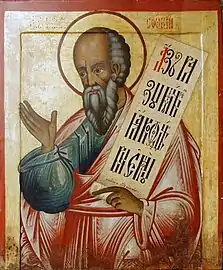 Prophet Zephaniah. (Russian Orthodox icon, 18th century).
Prophet Zephaniah. (Russian Orthodox icon, 18th century).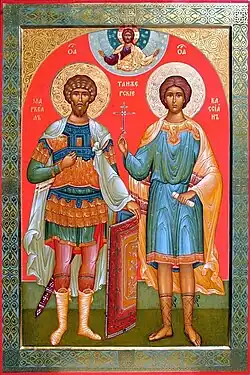 Orthodox icon of Saint Marcellus and Cassian of Tangier.
Orthodox icon of Saint Marcellus and Cassian of Tangier.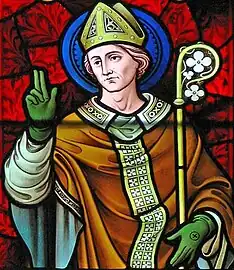 Stained glass Window of St. Birinus.
Stained glass Window of St. Birinus.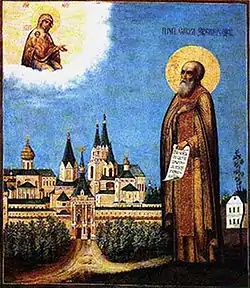 Icon of St. Savva Storozhevsky against the backdrop of a monastery, (19th century).
Icon of St. Savva Storozhevsky against the backdrop of a monastery, (19th century).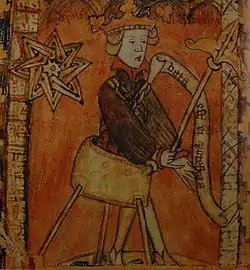 King Magnus Eriksson IV of Sweden, VII of Norway, on the title page of his Swedish national law (Magnus Erikssons landslag), c. 1350.
King Magnus Eriksson IV of Sweden, VII of Norway, on the title page of his Swedish national law (Magnus Erikssons landslag), c. 1350.
Notes
- ↑ The notation Old Style or (OS) is sometimes used to indicate a date in the Julian Calendar (which is used by churches on the "Old Calendar").
The notation New Style or (NS), indicates a date in the Revised Julian calendar (which is used by churches on the "New Calendar"). - ↑ "In Judea, the holy prophet Sophonias."[4]
- ↑ Some of these martyrs are also commemorated on December 28.
- ↑ Theodulus was an eminent Patrician at the court of Theodosius the Great. After the death of his wife, he renounced the vanity of the world and withdrew from Constantinople to a pillar near Ephesus, where he lived a life of asceticism for thirty years.
- ↑ Hieromartyr Theodore, Archbishop of Alexandria (606–609), suffered for Christ in Alexandria by idolaters who placed a crown of thorns on the head of St. Theodore and, after abusing him, beheaded him.[11]
- ↑ "At Coire, in Switzerland, St. Lucius, king of the Britons, who was the first of those kings who received the faith of Christ, in the time of Pope Eleutherius."[4]
- ↑ "ST. LUCIUS, whose festival is observed to-day according to the Roman Martyrology and the tradition of Switzerland and Bavaria, was Lucius, the first British prince who received the Faith of Christ. It is said that after his conversion and the acceptance of the Gospel by the greater number of his subjects, he resigned his dominions and went to preach in Germany, finally taking up his abode at Chur, in the canton of the Grisons, whence he was called to the reward of his labours in heaven, and, as some add, to the Martyr's crown. According to the same account, he was accompanied from Britain by his sister EMERITA, who eventually suffered martyrdom at Treves or at Chur."..."King Lucius is said to be Llewr Maur, and his principality to have been in or near Llandaff."[13]
- ↑ "At Tangier, in Morocco, St. Cassian, martyr. After having been a recorder for a long time, at length, through the inspiration of heaven, he deemed it an execrable thing to contribute to the massacre of the Christians, and therefore abandoned his office, and making profession of Christianity, deserved to obtain the triumph of martyrdom."[4]
- ↑ "In England, St. Birinus, first bishop of Dorchester."[4]
- ↑ A monk and priest from England who followed St Boniface to Germany and lived as a hermit first near Fulda later near Eichstätt. Finally he settled on a piece of land where he founded the monastery called Solnhofen as a dependency of Fulda monastery.
- ↑ See also: (in Russian) Иларион (Григорович). Википедии. (Russian Wikipedia).
- ↑ Saint Cosmas was a monk of St Anne's Skete on Mount Athos. He was executed in Constantinople on December 3, 1760 when he refused to convert to Islam. The specific details of his martyrdom are not known.[17]
- ↑ St George was glorified by the Romanian Orthodox Church in 2005. His holy relics are in the Cernica Monastery, where they are venerated by the faithful.
- ↑ According to the Russian Sofia First Chronicle, composed in Novgorod, Magnus in fact, did not drown at sea, but saw the errors of his ways and converted to Orthodoxy, becoming a monk in the Novgorodian monastery in Karelia.
References
- ↑ Great Synaxaristes: (in Greek) Ὁ Προφήτης Σοφονίας. 3 Δεκεμβρίου. ΜΕΓΑΣ ΣΥΝΑΞΑΡΙΣΤΗΣ.
- 1 2 3 4 5 6 7 8 9 10 11 12 13 14 December 3/16. Orthodox Calendar (PRAVOSLAVIE.RU).
- ↑ Prophet Zephaniah. OCA – Feasts and Saints.
- 1 2 3 4 5 6 7 The Roman Martyrology. Transl. by the Archbishop of Baltimore. Last Edition, According to the Copy Printed at Rome in 1914. Revised Edition, with the Imprimatur of His Eminence Cardinal Gibbons. Baltimore: John Murphy Company, 1916. pp. 372–373.
- ↑ Great Synaxaristes: (in Greek) Οἱ Ἅγιοι Ἀγάπιος, Σελεῦκος, Μάμας, Ἰνδῆς, Δόμνα, Γλυκέριος καὶ 40 Μάρτυρες ἐν Σοφιαναῖς. 3 Δεκεμβρίου. ΜΕΓΑΣ ΣΥΝΑΞΑΡΙΣΤΗΣ.
- ↑ Great Synaxaristes: (in Greek) Ὁ Ὅσιος Θεόδουλος ὁ ἀπὸ Ἐπάρχων. 3 Δεκεμβρίου. ΜΕΓΑΣ ΣΥΝΑΞΑΡΙΣΤΗΣ.
- ↑ Great Synaxaristes: (in Greek) Ὁ Ὅσιος Θεόδουλος ὁ Κύπριος. 3 Δεκεμβρίου. ΜΕΓΑΣ ΣΥΝΑΞΑΡΙΣΤΗΣ.
- ↑ Great Synaxaristes: (in Greek) Ὁ Ἅγιος Ἰωάννης ὁ Ἡσυχαστής, Ἐπίσκοπος Κολωνίας. 3 Δεκεμβρίου. ΜΕΓΑΣ ΣΥΝΑΞΑΡΙΣΤΗΣ.
- ↑ St John the Silent of St Sabbas Monastery. OCA – Feasts and Saints.
- ↑ Great Synaxaristes: (in Greek) Ὁ Ἅγιος Θεόδωρος ὁ Ἱερομόναχος Ἀρχιεπίσκοπος Ἀλεξανδρείας. 3 Δεκεμβρίου. ΜΕΓΑΣ ΣΥΝΑΞΑΡΙΣΤΗΣ.
- ↑ Hieromartyr Theodore, archbishop of Alexandria (606). HOLY TRINITY RUSSIAN ORTHODOX CHURCH (A parish of the Patriarchate of Moscow).
- 1 2 3 4 5 6 7 8 9 10 11 December 3. Latin Saints of the Orthodox Patriarchate of Rome.
- 1 2 3 Rev. Richard Stanton. A Menology of England and Wales, or, Brief Memorials of the Ancient British and English Saints Arranged According to the Calendar, Together with the Martyrs of the 16th and 17th Centuries. London: Burns & Oates, 1892. pp.580–581.
- ↑ Great Synaxaristes: (in Greek) Ὁ Ἅγιος Birinus (Ἄγγλος). 3 Δεκεμβρίου. ΜΕΓΑΣ ΣΥΝΑΞΑΡΙΣΤΗΣ.
- ↑ The Monk Savva of Storozhevsk and Zvenigorodsk. HOLY TRINITY RUSSIAN ORTHODOX CHURCH (A parish of the Patriarchate of Moscow).
- ↑ Great Synaxaristes: (in Greek) Ὁ Ἅγιος Γαβριὴλ ὁ Ἱερομάρτυρας Πατριάρχης Κωνσταντινουπόλεως. 3 Δεκεμβρίου. ΜΕΓΑΣ ΣΥΝΑΞΑΡΙΣΤΗΣ.
- ↑ Monkmartyr Cosmas of St Anne Skete, Mt Athos. OCA – Feasts and Saints.
- ↑ St George of Cernica and Caldarushani. OCA – Feasts and Saints.
- ↑ Great Synaxaristes: (in Greek) Ὁ Ἅγιος Ἀγγελὴς ὁ Νεομάρτυρας γιατρὸς ἀπὸ τὸ Ἄργος. 3 Δεκεμβρίου. ΜΕΓΑΣ ΣΥΝΑΞΑΡΙΣΤΗΣ.
- 1 2 3 December 16 / December 3. HOLY TRINITY RUSSIAN ORTHODOX CHURCH (A parish of the Patriarchate of Moscow).
- 1 2 The Autonomous Orthodox Metropolia of Western Europe and the Americas (ROCOR). St. Hilarion Calendar of Saints for the year of our Lord 2004. St. Hilarion Press (Austin, TX). p.90.
- 1 2 3 (in Russian) 3 декабря (ст.ст.) 16 декабря 2013 (нов. ст.). Русская Православная Церковь Отдел внешних церковных связей. (DECR).
Sources
- December 3/16. Orthodox Calendar (PRAVOSLAVIE.RU).
- December 16 / December 3. HOLY TRINITY RUSSIAN ORTHODOX CHURCH (A parish of the Patriarchate of Moscow).
- December 3. OCA – The Lives of the Saints.
- December 3. Latin Saints of the Orthodox Patriarchate of Rome.
- The Roman Martyrology. Transl. by the Archbishop of Baltimore. Last Edition, According to the Copy Printed at Rome in 1914. Revised Edition, with the Imprimatur of His Eminence Cardinal Gibbons. Baltimore: John Murphy Company, 1916. pp. 372–373.
- Rev. Richard Stanton. A Menology of England and Wales, or, Brief Memorials of the Ancient British and English Saints Arranged According to the Calendar, Together with the Martyrs of the 16th and 17th Centuries. London: Burns & Oates, 1892. p. 579–583.
Greek Sources
- Great Synaxaristes: (in Greek) 3 ΔΕΚΕΜΒΡΙΟΥ. ΜΕΓΑΣ ΣΥΝΑΞΑΡΙΣΤΗΣ.
- (in Greek) Συναξαριστής. 3 Δεκεμβρίου. ECCLESIA.GR. (H ΕΚΚΛΗΣΙΑ ΤΗΣ ΕΛΛΑΔΟΣ).
Russian Sources
- (in Russian) 16 декабря (3 декабря). Православная Энциклопедия под редакцией Патриарха Московского и всея Руси Кирилла (электронная версия). (Orthodox Encyclopedia – Pravenc.ru).
- (in Russian) 3 декабря (ст.ст.) 16 декабря 2013 (нов. ст.). Русская Православная Церковь Отдел внешних церковных связей. (DECR).
This article is issued from Wikipedia. The text is licensed under Creative Commons - Attribution - Sharealike. Additional terms may apply for the media files.

